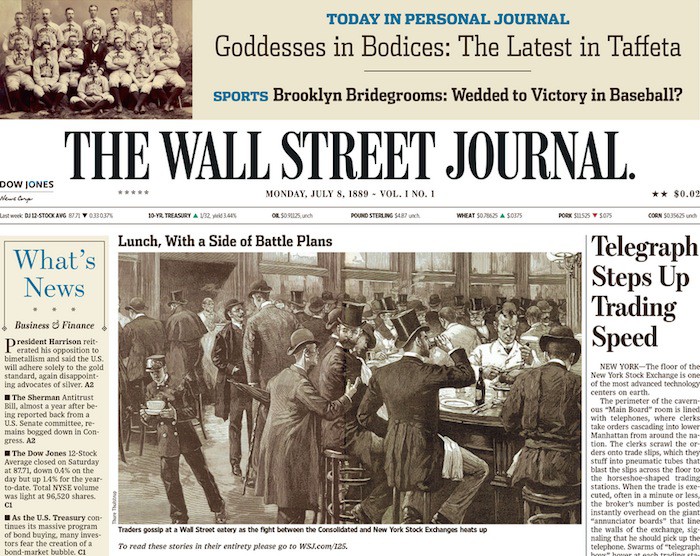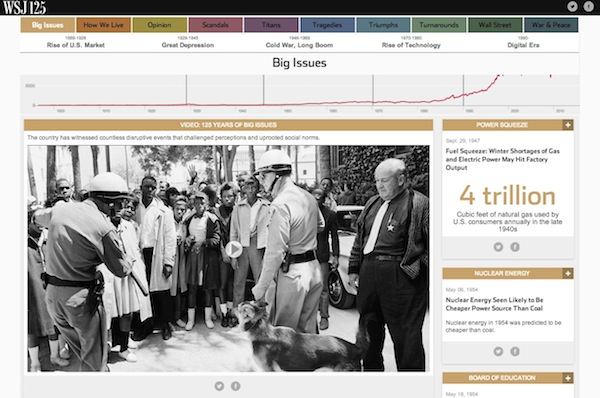
The Wall Street Journal marked its 75th anniversary on July 8, 1964 with a front-page story examining the paper’s history and what the paper stood for. Though initially conceived as solely a business newspaper, the Journal wrote at the time that its view is that business news covers “everything that somehow relates to making a living.”
“Journal coverage of such news is shaped by a belief that to understand or explain business, it’s necessary to look at what people are doing, thinking and feeling about matters that are seemingly remote from ‘business,’ but that influence it indirectly,” the Journal wrote.
Because of that expanded editorial approach, as the Journal today marks its 125th anniversary with a special print section and a series of online interactives — including a timeline with more than 300 archival clips — the paper is able to take advantage of its broad and deep archive to mark its quasquicentennial — as well as to use its archives and what it has developed for the anniversary beyond the current celebration.

The anniversary package includes a lot of material — Taylor Swift’s contribution seems to be getting the early attention — and that includes an array of interactives. The timeline allows users to search by era or themes to examine Journal content from the past 125 years. There are videos embedded in the interactive, and original Journal content is presented on individual cards that expand to show full stories and are also shareable. A game of sorts, scheduled to be published later this week, asks readers place individuals who influenced the world of business — from Steve Jobs to Charles Ponzi — on a grid to measure their influence and innovation. Users can leave comments on why they placed a person where they did and the matrix will also show the averages of where all users put an individual.
The paper has also been running a blog all year long, Today in WSJ History, that’s has been updated with archival content that corresponds with dates in history and anniversaries, like the 50th anniversary of the Beatles arriving in America, and also to modern news events. For instance, when the director Harold Ramis died earlier this year, they posted two stories from the archives on the director.
The blog will be updated through the end of the year, but the Journal plans to ensure that the interactive presentation of its archival material is active past the anniversary date, Matt Murray, the Journal’s deputy editor-in- chief, said.
“This is something that will live well beyond the anniversary,” Murray said. “We can use it in museums — we can keep adding to it. It’s just a much more engaging fun way of getting into our archives than going through microfilm and going page after page.”
Surfacing archival content is a natural priority for any news organization with a lifespan spanning centuries. The New York Times’ leaked innovation report highlighted improved use of archives as a potential strategic advantage for the Times, and the same idea applies to most newspapers.The Journal is still working out the details on how exactly it will build on the interactives after the anniversary. Multimedia editor Madeline Farbman said that, for example, the matrix game (which she helped create) could be reused whenever one of the figures on it is back in the news.
“The people who are on it they remain in the news, so when they’re in the news, you resurface this and you give it another chance to be found with whatever the latest story is,” she said.
On the print side, the Journal is wrapping today’s newspaper with a facsimile copy of its first-ever edition that’s annotated with additional details and modern information on what the Journal covered on July 8, 1889. (However, if you want to pick up a copy, it’ll cost you $2, not two cents like it did in 1889.)
They’ve also produced a mockup of a front page of the 2014 Journal if it covered the news in 1889. (Today in Personal Journal: Goddesses in Bodices: The Latest in Taffeta.)
But the heart of the print section, which is also featured in the European and Asian versions of the paper, is a series of essays, called The Future of Everything, examining the future of various industries written by leaders in those fields. Along with Swift, Facebook’s Mark Zuckerberg is in there, writing on connectivity. There’s also a special opinion section. All of the print content will, obviously, be on the Journal’s website as well. While the interactives will be outside the Journal’s paywall, only a few of the essays will be free to read for non-subscribers.
Still, the interactives have been designed for sharing as each individual story or video on the timeline is shareable, and the Journal has been working with the contributors to encourage them to share what they’ve written as well. Taylor Swift, she of the 41 million Twitter followers, retweeted a @WSJ tweet of her piece, which helped drive it to nearly 7,000 retweets and favorites at this writing.
Taylor Swift on the future of music for our #WSJ125 anniversary special: http://t.co/XV5M05xby3 pic.twitter.com/nMNJ0g0kL4
— Wall Street Journal (@WSJ) July 7, 2014
(It also drove the kind of Twitter replies one imagines @WSJ rarely gets.)

The Journal has used social media in the run-up to the anniversary, asking readers to participate in the celebration by sharing photos of old copies of the Journal that they’ve saved. And readers can also expect a concerted effort from the Journal to promote its anniversary package.
Which news events have meant the most to you? Send us a photo of the copy of the @WSJ you've saved: http://t.co/eohfPLKC4F #WSJ125
— Wall Street Journal (@WSJ) July 2, 2014
“We’re using SEO and [social] and all kinds of other methods to bring in new readers who don’t already know who we are,” said social media editor Allison Lichter. “This is another extension of that.”